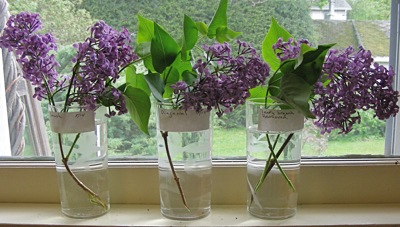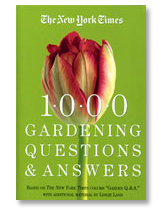Lilacs that Last, Part 1: Bouquets (plants coming in part 2)
Ok, let’s start by being honest. Lilac bouquets do not last, period. Or at least they don’t last like tulips, say, or peonies, or even roses. This is partly because lilacs wilt fast and partly because there’s no wiggle room: tulips and peonies and roses remain beguiling in decline; lilacs look awful as soon as they don’t look wonderful.

To keep them looking wonderful for as long as possible:
* Choose trusses that are about half open – if they’re mostly buds, they’ll just give up before going any farther and if every florette is blooming the end is already near.
* Cut them early in the morning before the bark heats up and put them up to their necks in the large bucket of tepid water you have right with you.
* Prepare the vase. Fill a deep, squeaky-clean glass, ceramic or other non-reactive container with tepid water. Add commercial flower preservative – it won’t feed the flowers but it will help prevent the buildup of decay-causing bacteria.
* Remove all the leaf stems (see Experiment Report below), saving the longest and prettiest to add to the bouquet. Trim off anything dead. Do whatever else you want to do to the stems and then cut the bases on a sharp diagonal to allow maximum water exposure. Lilacs are big drinkers.
I grew up firmly believing that smashing the bases with a hammer to increase water takeup area was the key to lasting bouquets. Then I learned this was unwise because it crushes the cells and crushed cells can’t take up anything. Then I did the Experiment, which suggested that a moderate smash doesn’t matter much either way.
* Display the bouquet out of direct sun and away from fruit. Remove any blossoms that start to look forlorn as soon as you notice them. Ripening fruit and dying vegetable matter both give off ethylene gas, which hastens decay.
* Change the water every day or every other day; preservative helps prevent nastiness but you can’t expect it to do everything. If you want to go the extra mile and get a couple of extra days, store the bouquet in a cool room each night.
LILAC FLOWER KEEPING EXPERIMENT

Day one of the trial
Not science. Not even close to science because I only did it once and because it’s really hard to get 3 trusses that are exactly equal in age, stem size and other important variables.
Plus it was close to the end of the NY lilac season when I did it, so it was difficult to get the correctly half-open trusses. But there was one conclusion so unmistakable I’m now a complete convert.
All I did was set up 3 glasses ( photographed in the window but kept in the cool dark). Smashed stem in one, diagonal cut stem in the next, stem with all leaves removed – advised in From Garden To Vase, by Linda Beutler and Allan Mandell – in the third. Did not add preservative.
By the third day, both smash and slit were starting to look tired, while the leafless flower, with detached leaf stems in the glass, was still quite perky.
On day 5, the results were in. All three flowers were done for, but not to the same degree. Smash was a little bit worse than slit and its water was much murkier. Preservative might well have been helpful. Slit was slightly better than smash but still too droopy to keep. Leafless was no longer presentable by day but could have passed in candlelight. It was significantly better preserved than either of the others.
So when I got to Maine, where the lilacs were just approaching full gorgeous (and in a sort of suspended animation because it was so damn cold). I pruned a couple of needy President Lincolns and made the bouquet shown here.
Took off all the leaf stems. Did not add preservative (out of same). Been changing water and storing in cool room. Removed one small wilty clump. When the picture was taken yesterday the bouquet was a week old and it still looks fine this morning.















Trackbacks/Pingbacks
Get a Trackback link